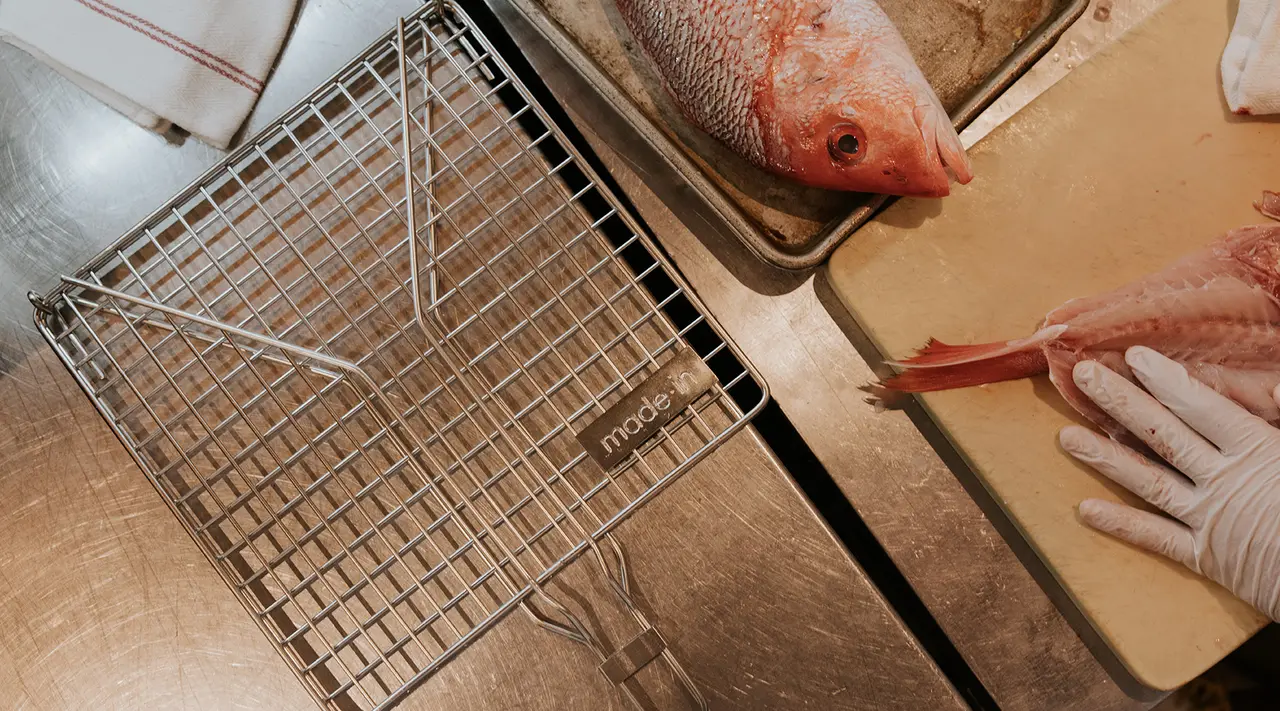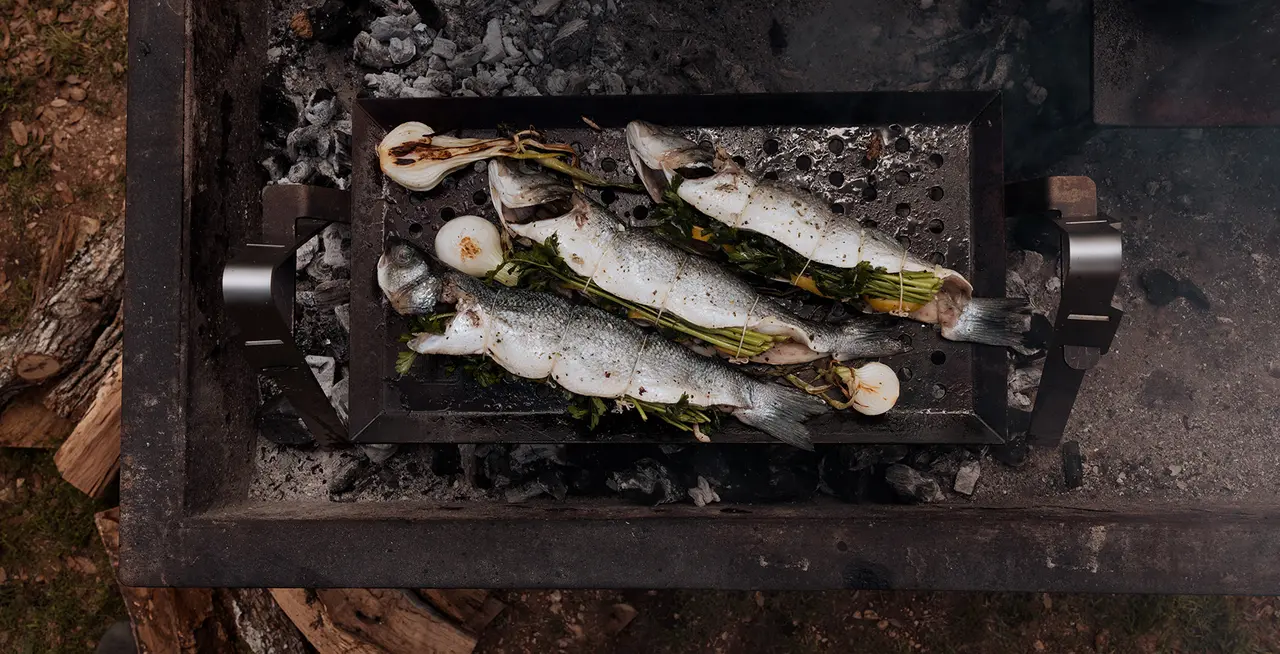If you’ve never tried grilling fish before, we can honestly say you’re missing out. Grilling yields flaky fish with beautifully charred, crackly skin—perfect for drizzling with a punchy salsa verde or tucking into a warm corn tortilla. It’s also one of our favorite ways to cook whole fish—while this involves a bit of added prep work, the reward is well worth the effort.
Here, we’ve given you the lowdown on how to properly cook fish on the grill. Read on to learn which types of fish are best for grilling, what kind of prep you’ll need to do, and what tools you should have on hand. We also go over some of the most common pitfalls you’ll encounter when cooking fish on the grill, and what steps you can take to avoid them.
How to Grill Fish

While grilling fish shouldn’t feel intimidating, there are a couple of things to be conscious of. As a delicate protein, fish skin is notorious for sticking to cooking surfaces, especially pans and grill grates that haven’t been greased or heated properly. If you’re not careful, you could lose that deliciously fatty, crispy skin you worked so hard to achieve.
Other than thoroughly greasing your grates—or for whole fish, a fish basket—you’ll want to make sure to add your fish to the grill only once it’s really hot so that the skin releases naturally.
If you’re using a fish basket to cook your fish, flipping is easy. After making sure that you’ve securely locked the basket in place, simply grab the handle and rotate it. If you don’t have a fish basket, however, flipping a whole fish can get a bit trickier. Here’s how to do it using two fish spatulas.
- First, slide one of the spatulas part way under the fish to carefully lift it up.
- With the fish lifted, slide the other spatula underneath the first, then remove the first spatula so that the fish is resting on the second one.
- Place the first spatula on top of the fish in roughly the same position as the first spatula, then use both spatulas to gently flip the fish on to the other side.
Your fish is done cooking when a digital thermometer inserted into the thickest part reads about 135F, or the fish looks opaque and flakes slightly when you press down on it with a spatula. A whole fish is harder to overcook than a filet, but you can also avoid overcooking by setting up two different heat zones on your grill—that way, you can move your fish over to the cooler side to finish cooking if the skin browns before the inside is done.
Best Tools for Grilling Fish
Because fish tends to be a bit more delicate than other proteins, good tools are essential for yielding fish with evenly cooked, tender flesh, as well as skin that’s crisp, not burnt. Here are three of our favorite tools for the job.
For Whole Fish: The Fish Basket
A fish basket is essentially a wire cage with a handle and locking mechanism, and allows you to turn your fish throughout the cooking process while keeping it securely locked in place. This makes it much easier to flip your fish when it’s finished cooking on one side, and also helps to prevent sticking. Our stainless steel fish basket is sturdy enough to hold up to years of grilling and open fire cooking without rusting, and is carefully designed to keep your fish—or other ingredients—from sliding out.
For Seared Fish: The Carbon Steel Griddle
A carbon steel griddle is an excellent tool to use on the grill itself: Wide and flat, a griddle maximizes contact between the cooking surface and the fish, resulting in a deeply crispy, burnished crust. Its impressive heat retention is perfect for the hot, fast cooking methods that seem to particularly suit fish (see: blackened red snapper). Since well-seasoned carbon steel is naturally non stick, you’ll also have an easier time cleaning up afterwards—no more scraping burnt skin off the grates.
There are plenty of variations on the Griddle to choose from—our Paella Pan and Comal are both, at least functionally, large circular griddles. But our newest introductions to the family, namely the Grill Griddle and the Half Griddle, are where the versatility really comes through. With their perforated and partially perforated surfaces respectively, the results are more charred, a bit smokier, and more like traditional grilled ingredients.
For Grilled Fish Filets: Carbon Steel Grill Frying Pan
A carbon steel grill frying pan combines the high heat resistance of carbon steel with a perforated bottom for more contact with the flames. Much smaller than the Griddle, its maneuverability allows you to easily flip fish and move it around the grill’s heat zones.
For Just-Caught Fish: The Griddle System
For those who love to fish, camp, or both, the Griddle System is non-negotiable. Simply put, it’s a modular restaurant-style flat top designed for indoor-outdoor cooking over any kind of flame. In addition to the Griddle, the Set comes with an adjustable Stand, a rust-resistant Lid, and a Stainless Steel Grill Press, so you can cook whatever, however, and wherever you like. The detachable Stand features two height settings geared towards different heat sources and intensities, but also allows you to use your Griddle on the stove.
What’s the Best Fish for Grilling?

While most fish do well on the grill, we like to use fish with firm, meaty flesh that’ll stand up well to the high heat of the grill and won’t overcook too easily. For whole fish, you can try grilling small- to medium-size fish like branzino, porgy, mullet (also called snapper), or redfish. Small fish, like sardines and anchovies, are also fantastic grilled. For steaks or filets, we love a piece of grilled salmon, halibut, or a tuna or swordfish steak.
How to Prep Fish
With freshly-caught fish, all you really need is salt, cracked black pepper, and a finishing squeeze of lemon or lime. You can also try stuffing whole fish with aromatics such as sprigs of fresh tarragon, thyme, or rosemary, as well as sliced citrus fruits like oranges or lemons. Much like stuffing a chicken, this will help to flavor your fish from the inside out. A quick marinade before grilling can add an additional layer of flavor to your fish.
As for cleaning your fish, you can totally go ahead and gut and scale it all on your own—this is easier if you have a set of Fish Knives— but if you’re buying your fish from a fishmonger, you can ask them to do that bit for you.
Ready to Cook?
We’ll say it again: Grilling fish is one of the most rewarding experiences you can have while cooking outdoors, and one that’s easy to achieve at home. And while you could toss your fish straight on the grill, those looking for a more streamlined experience—not to mention more control throughout the cooking process—should definitely give our Griddles, Grill Pans, and Fish Baskets a whirl.
































